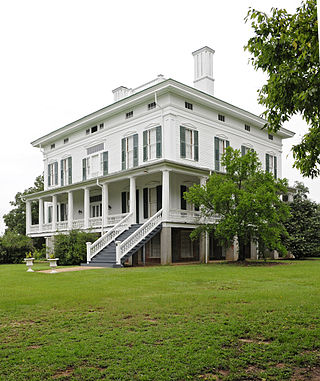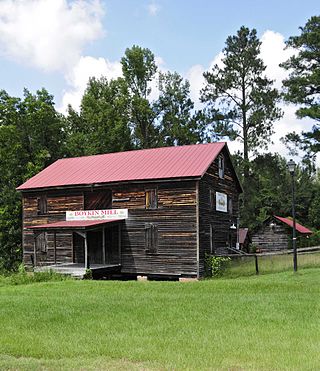Related Research Articles

Stagville Plantation is located in Durham County, North Carolina. With buildings constructed from the late 18th century to the mid-19th century, Stagville was part of one of the largest plantation complexes in the American South. The entire complex was owned by the Bennehan, Mantack and Cameron families; it comprised roughly 30,000 acres (120 km2) and was home to almost 900 enslaved African Americans in 1860.

Redcliffe Plantation State Historic Site is a state park in South Carolina, United States. Redcliffe Plantation, also known as Redcliffe, completed in 1859, is a Greek Revival plantation house located on the site that is listed on the National Register of Historic Places. The house was designed by the baron Louis Berckmans and was built in 1857. It was built for James Henry Hammond and was home to three generations of his descendants. His great-grandson John Shaw Billings, editor of Time, Life, and Fortune magazines, donated the estate and collections to the people of South Carolina in 1973. The same year it was added to the National Register of Historic Places.

Mulberry Plantation is a historic plantation property in rural Berkeley County, South Carolina. Located between Moncks Corner and Charleston, this property was developed in 1714 by Thomas Broughton, who became the Royal governor of South Carolina, and is one of the oldest plantation homes in the United States. Its rice fields, dikes and canals were well-preserved into the 20th century. The plantation house and ten surrounding acres were declared a National Historic Landmark in 1963.

Mulberry Plantation, also known as the James and Mary Boykin Chesnut House is a historic plantation at 559 Sumter Highway south of Camden, South Carolina. Declared a National Historic Landmark in 2000, it is significant as the home of American Civil War chronicler Mary Boykin Chesnut, who produced some of the most important written accounts of the war from a Confederate perspective. The main house, built about 1820, is a fine example of Federal period architecture.

Ashley River Historic District is a historic district located west of the Ashley in the South Carolina Lowcountry near Charleston, South Carolina, United States. The Historic District includes land from five municipalities, almost equally split between Charleston and Dorchester counties. The district includes dry land, swamps, and marshes of the Rantowles Creek and Stono Swamp watershed.

The Carson House is a historic house and museum located in Marion, North Carolina. It was the home of Col. John Carson, and served as the McDowell County courthouse when the county was first organized in 1842.
Hasell Point, an “address restricted” landmark in Beaufort County, South Carolina, with its mix of burial mounds, potter and an oyster shell midden, is a potentially important archaeological site, one that may yield significant information dating to 500 AD. Hasell Point was listed in the National Register of Historic Places on August 14, 1973.
Laurel Bay Plantation, also known as Woodward Plantation and Tabby Ruin Site, is a historic archaeological site located near Beaufort, Beaufort County, South Carolina. The site contains artifacts associated with domestic outbuilding activities related to either or both Laurel Bay Plantation and Woodward Plantation. Features present at the site include sections of two tabby walls, a tabby structure foundation, two depressions, two brick piles, and a shell pile.
Lawton Mounds is a historic archaeological site located near Johnson's Landing, Allendale County, South Carolina. The site consists of two low earthen flat-topped mounds and surrounding village area, enclosed by a ditch and parapet. The North Mound is essentially rectangular, 65 feet by 70 feet at the base, standing 5 feet above the terrace. The South Mound is 100 feet distant from the first, also rectangular, 70 feet by 85 feet at the base and 7 feet, 6 inches high.

McCollum Mound, also known as Turkey Creek Mound and village, is a historic mound and village site located near Chester, Chester County, South Carolina. The site is one of less than two dozen mounds of aboriginal origin in the state of South Carolina. The mound was built in three, or possibly more, stages. The Turkey Creek mound and village were probably inhabited during the late prehistoric and early historic periods. The mound is located on the Broad River approximately 500–600 feet downstream from the McCollum Fish Weir.

Santee Indian Mound and Fort Watson is a historic archaeological site located in North Santee, Clarendon County, South Carolina, near Summerton. Santee Indian Mound was part of a Santee mound village complex; it was probably a burial and/or temple mound, likely constructed in some cultural period between 1200–1500.
Blair Mound is a historic archaeological site located near Winnsboro, Fairfield County, South Carolina. Blair Mound is an earthen mound structure in the form of a low, oval hummock. It measures approximately 75 by 50 yards and is just over 5 feet (1.5 m) high, with evidence of leveling for agricultural development.
Richmond Hill Plantation Archeological Sites consists of five historic archaeological sites located near Murrells Inlet, Georgetown County, South Carolina. The Richmond Hill Plantation complex sites include remains of the planter's house, two possible overseers' houses, approximately 20 slave houses, a slave cemetery, a rice barn, and rice fields and dikes. The plantation house, overseers' houses, and slave houses were all burned by about 1930. Richmond Hill plantation was owned by Dr. John D. Magill, who was considered one of the least efficient planters in the area and the most brutal slaveowner among the Georgetown District rice planters.
The Adamson Mounds Site (38KE11) is an archaeological site located near Camden, Kershaw County, South Carolina. It is a prehistoric Native American village site containing one large platform mound, a smaller mound, possibly a third still smaller mound, and a burial area. It served as a regional ceremonial center. This site represents a widespread, late prehistoric Mississippian culture known by the names of Lamar, Irene, or Pee Dee and dates probably between AD 1400 and AD 1700.
The Belmont Neck Site is a historic archaeological site located near Camden, Kershaw County, South Carolina. From about 950 to 1300 A.D., the Belmont Neck Site was the location of a platform mound and town associated with the Native American chiefdom of Cofitachequi. It appears to be the first of 12 mound towns along the Catawba/Wateree River. From approximately 1772 to 1796, it was the location of indigo production by Colonel John Chesnut of Camden.
Midfield Plantation, also known as Ellerbe House and Boineau House, was a historic plantation house located near Boykin, Kershaw County, South Carolina. It was built about 1821, and was a two-story, hip roofed, frame dwelling on a high masonry basement. It had rear additions added about 1900. The original kitchen and smokehouse are still on the property as remains.
Benjamin McCoy House, also known as Banbury Cross, is a historic home located near Cassatt, Kershaw County, South Carolina. It was built about 1820, and is a two-story I-house. It has heavy timber-frame construction and brick exterior brick chimneys.

Boykin Mill Complex, also known as Mill Tract Plantation, is a national historic district located near Camden, Kershaw County, South Carolina. The district encompasses nine contributing buildings, two contributing sites, and four contributing structures. “Boykin Mill” denotes a community which consists of an old post office, an old general store, a c. 1905 grist mill, mill pond, mill dam, gates, and canals. The community also includes an early 19th-century Greek Revival style Baptist church, one mid-19th-century residence, three 20th-century residences built for mill workers, and a smoke house. An American Civil War battle site is also a part of the Boykin Mill community. The Battle of Boykin's Mill took place on April 17, 1865.
Rosemont Plantation is a historic archaeological site located near Waterloo, Laurens County, South Carolina. Development of the Piedmont plantation complex was begun sometime between 1750 and 1790. It reached its zenith as a cotton plantation during the second quarter of the 19th century, when it was occupied by the Cunningham family, whose descendants retained control. The main house of Rosemont burned in 1930. The Cunninghams sold it after that.
Auld Mound (38CH41), also known as Yough Hall Plantation Shell Ring, is a historic mound located near Mount Pleasant, Charleston County, South Carolina. It is one of 20 or more prehistoric shell rings located from the central coast of South Carolina to the central coast of Georgia. On average, it measures 174 feet in diameter and stands 2 to 3 feet high. The midden is largely composed of oyster shell.
References
- 1 2 "National Register Information System". National Register of Historic Places . National Park Service. July 9, 2010.
- ↑ Robert L. Stephenson (March 1970). "McDowell Site" (nomination form). National Register Properties in South Carolina. National Register of Historic Places - Nomination and Inventory. South Carolina Department of Archives and History. Retrieved June 3, 2014.
{{cite web}}: External link in|format= - ↑ "McDowell Site, Kershaw County (Address Restricted)". National Register Properties in South Carolina. South Carolina Department of Archives and History. Retrieved June 3, 2014.

